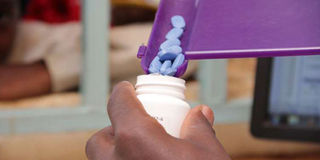Doctors prescribe more drugs than recommended, study says

A pharmacist puts medicine inside a bottle. PHOTO | JOSEPH KANYI | NATION MEDIA GROUP
What you need to know:
- Research was conducted by the University of London and Ghana’s Health Policy Consult.
It involved analysis of the medication prescribed to patients in 11 countries.
Doctors in Kenya prescribe to patients more drugs than recommended, a new study says amid growing concern in Sub-Saharan Africa about medicines losing their potency to cure diseases.
Kenya, alongside 10 other African countries, was part of the study “Prescribing indicators at primary health care centres within the WHO African region: a systematic analysis (1995–2015)”.
A report on the study was published on Monday in the BMC Public Health journal.
The research was conducted by the University of London and Ghana’s Health Policy Consult.
It involved analysis of the medication prescribed to patients in 11 countries.
According to the study, patients seeking treatment in the Sub-Saharan region are likely to take more medicine than they should ideally be given, leading to misuse or overuse of the drugs.
The study showed that in the region, patients are given an average of three different drugs per hospital visit when the World Health Organisation (WHO) recommends a maximum of two.
The authors warned that the use of many medicines by a patient, a phenomenon called polypharmacy, “is likely to result in increased risk of adverse drug interactions, dispensing errors and decreased patients’ knowledge of the correct doses of medications”.
Inappropriate prescription of drugs by health workers has been cited by pharmacists as one of the reasons for antimicrobial resistance.
Antimicrobial resistance is a broad term used by microbiologists and the WHO to describe what occurs when bacteria, viruses, fungi and parasites change in ways that render the medications used to cure the infections they cause ineffective.
Antibiotics resistance, on the other hand, is a term used to describe the declining ability of antibiotics to treat diseases.





